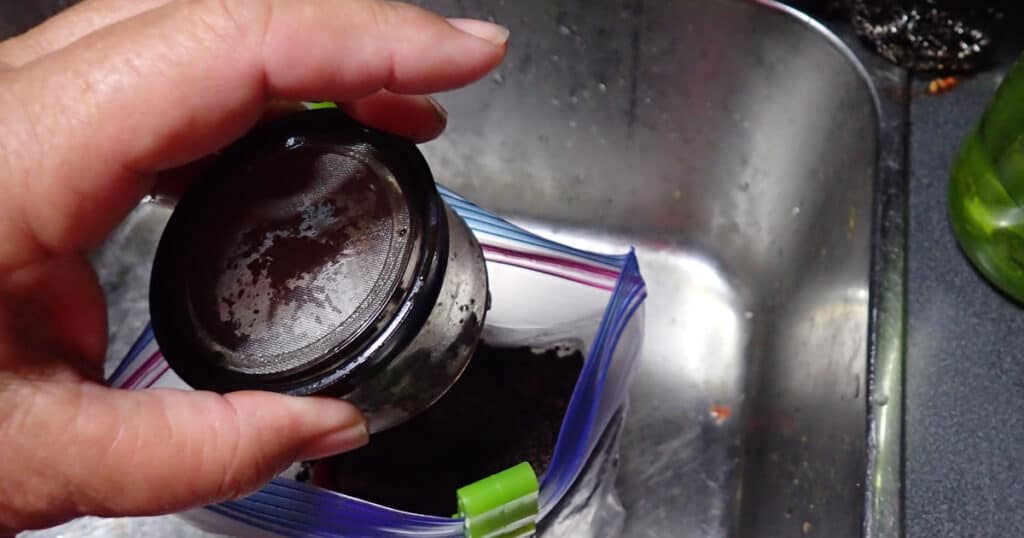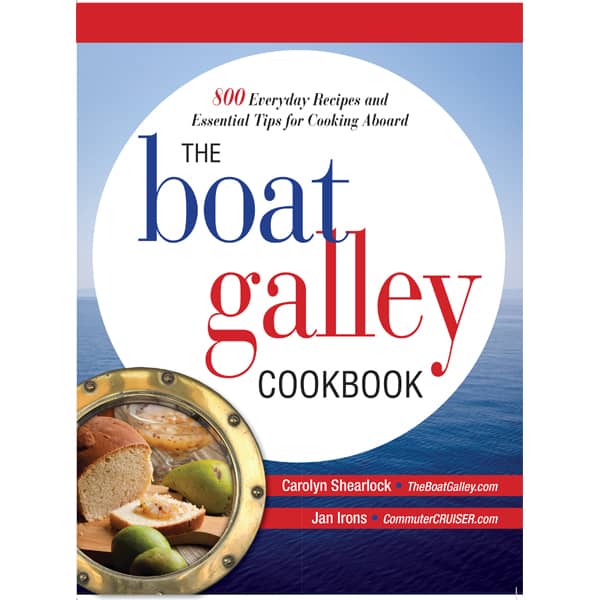Dealing with garbage on a boat is nobody’s cruising dream. It’s not pretty. In fact, it stinks. And by “garbage,” I’m talking about food scraps, not just general trash.
So what do you do with garbage on a boat when you’re on a short trip, charter or coastal cruising? (Ocean passages, where you may be at sea or a month or more, will require some different techniques.)
Steps to Garbage Management for Cruisers
The key to dealing with garbage on a boat is taking a multi-prong approach. And while I’m mostly writing for cruisers taking short trips or doing coastal cruising, I’ll link to resources that can help anyone devise the right trash management plan for their vessel.
Reduce the Garbage You Bring Aboard
The best way to keep from being overwhelmed with garbage when coastal cruising is to not bring it aboard to begin with. That means careful planning when provisioning. It may involve canning your own meat and produce ahead of time. And it certainly means leaving cardboard behind before dinghying back to the mother ship.
I devised a pretty complete list of tips for reducing the cardboard you bring aboard. Maybe it will spur your thinking. Or if you have a favorite tip, leave it in the comments below.
Of course, cardboard is not the only type of trash that can overwhelm your cruising boat. Check out my suggestions for reducing other kinds of trash on your boat.
But once you’ve done all you can to reduce trash on your boat, how do you manage what you end up with?
Dealing with Garbage on a Boat – Daily Practice
Garbage has two main problems: it stinks, and it attracts bugs (and worse). In a warm climate, both happen very quickly.
Avoid Odor and Bugs
Luckily, putting your garbage in an airtight container solves both problems. I usually have a wide-mouth jar that’s trash itself and I just put the garbage in it and keep the lid on tight. Peanut butter, mayonnaise and jelly jars are all great candidates. You can also use margarine and yogurt tubs, but the lids can be a little more prone to pop off.
If I don’t have a suitable jar or tub, I use an old Ziploc bag or perhaps an old bread wrapper — again, taken from the trash. The big thing is to make sure the bag doesn’t have any holes in it and that you can seal it up tightly. Sometimes with a Ziploc, “crud” will get into the zipper ridges and prevent the bag from staying sealed.
If the container isn’t airtight or comes open, the smell will probably be your first clue. Swarming bugs around it are another sure sign. Take care of the problem immediately — no matter how bad it smells — as it emphatically will not get better by itself. You do not want a stinky garbage mess to suddenly turn into a stinky garbage mess with a bug infestation. If you’ve had a problem, it can help to give a squirt of bug spray in the trash can after you’ve cleaned up any spill.
Keep Trash from Overwhelming the Space
Hopefully, by reducing what you bring aboard, you don’t have to store a ton of trash until you can dispose of it. But let’s face it, no one (no matter how large their vessel) has ever complained of too much space.
Luckily, you can make your trash take up less room by compacting it. It will store in less space until you can dump it.
Through trial and error, I’ve come up with the best ways to compact everything from plastic jars to tin cans. Check out my best tips for compacting boat trash.
One cruiser recommended an interesting method to me. It’s nothing I’ve ever tried. But it makes sense, if it does take some effort. It’s “cooking” your trash. Apparently, they used their GoSun solar cooker (Amazon) to bake small amounts of food waste. Once it was done, the amount of trash was reduced by 80%.
If you have a solar cooker on board, it couldn’t hurt to experiment. After all, the sun is free. And why not try to get more use from your solar cooker if you’re not using it every day?
Discarding Garbage
Finally, you have to discard the trash you’ve collect. We always dispose of the “garbage jars” with the rest of our trash when we get to a town or anchorage with some sort of trash service.
Some people suggest throwing garbage overboard on the grounds the sea life will eat it or that it’s biodegradable. I don’t like to do that.
All you have to do is walk the beach anywhere that garbage is thrown in the water to see the result. Okay, you don’t see as much food as plastic, but a lot of that garbage does end up on shore or on the ocean bottom just offshore. Fruit peels, especially oranges, are usually prevalent. I remember snorkeling beautiful reefs in the BVI and finding banana peels. YUCK!
That just doubled my resolve not to throw food scraps in the water.
If you’re cruising in remote areas, like we did in the Sea of Cortez, you might consider burning your trash. Some cruisers make an occasion of burning trash–always a good excuse for a party on the beach.
Of course, if you’re going to burn trash, you want to do it right. Don’t burn plastic. And don’t cause more problems than you solve. I’ve written about some best practices for burning garbage while cruising.
Final Thoughts about Garbage on a Boat
As you can see, I’ve spent a lot of time thinking about garbage. Hopefully I’m pointing you in the right direction to avoid it becoming a hassle.
But it’s an important job to get right. Your enjoyment of your vessel and the beauty of the natural areas we’re drawn to depend on it.
Related Posts

Carolyn Shearlock has lived aboard full-time for 17 years, splitting her time between a Tayana 37 monohull and a Gemini 105 catamaran. She’s cruised over 14,000 miles, from Pacific Mexico and Central America to Florida and the Bahamas, gaining firsthand experience with the joys and challenges of life on the water.
Through The Boat Galley, Carolyn has helped thousands of people explore, prepare for, and enjoy life afloat. She shares her expertise as an instructor at Cruisers University, in leading boating publications, and through her bestselling book, The Boat Galley Cookbook. She is passionate about helping others embark on their liveaboard journey—making life on the water simpler, safer, and more enjoyable.
Simplify meal prep on board with proven strategies for provisioning, maximizing fridge space, and cooking delicious meals aboard your boat.










Carolyn Shearlock says
Well, let’s see . . . Thanks for liking the site!
Many boats don’t have a large freezer — or even a freezer at all. So they may not be able to put garbage into the freezer. I’m guessing that most boats just don’t have this option, but thanks for suggesting it for those who do. And they don’t have the space for a blender/food processor, nor want to use the electricity for garbage. And little bits of food garbage are just as ugly as big ones, and really, the fish don’t eat it. So I doubt that this would work well for many boaters.
Chris says
we were kayaker for years and hated finding fruit peels and egg shells on beaches where we camped. now that we are boaters our method is my parents old vitamin blender. that thing will make a smoothie out of anything. banana peels, watermelon and cantaloupe rinds, orange peels get blended until it goes thru a strainer. turns into organic sludge that I dispose of when we get out of the harbor.
Carolyn Shearlock says
Good points, Dave. I’ve written a number of articles here on the many facets of Trash Management, including thinking about it when buying goods, ways to store it aboard and even what to do if burning it seems the best option. It’s a real problem, not just on a boat but ashore, too. Even where there are landfills as opposed to just “dumping grounds,” much ends up in the landfill that could be recycled or composted. For example, where I live there is no glass recycling despite the fact that glass is one of the easiest things to recycle.
The Boat Galley says
Glad you’re finding it helpful!
Dave Skolnick (S/V Auspicious) says
Hi Cookie,
Best wishes to you. Some thoughts for you: plenty of things will change when you move aboard. Don’t try to change your cooking and eating habits right off the bat. Give yourself a year to get used to your new environment before you change things that can stay the same for a while.
With respect to canning it does work and it isn’t hard. Canned foods last almost indefinitely, at least for cruising purposes. You can certainly can chili with ground beef. I can’t think of anything you can find in a can on the shelf in the grocery that you can’t do yourself.
In my experience the things I can find commercially in cans tend to be a better value as long as they taste good to us. We can homemade pasta sauce, our family chili, and some stews and other dishes we really like. We also make pickles and some other odds and ends that we like when we are away from big shopping.
A couple of articles are recommend are Beth Leonard’s piece on canning: http://bethandevans.com/pdf/Canning.pdf and the USDA guidelines on home canning: https://nchfp.uga.edu/how/can#gsc.tab=0
I carry a 5 l Kuhn Rikon pressure cooker (which was a ‘moving aboard’ change for me) we cook in – including non-pressure dishes like pasta – and a 16 qt pressure canner we also use for crab boils and other “big pot” needs aboard.
sail fast and eat well, dave
S/V Auspicious
Becky Croston says
I would recommend a class on canning too — our County Extension office has classes and advice. Faulty canning can make you ill –or worse!
Becky Croston says
Thanks Cindy! –I’ve waited for hints for “this ” area (Pac. N.W.) We’re going up to Alaska for five months and I’m hungry for help!
The Boat Galley says
Many don’t really get eaten. They just float on the surface and it’s pretty yucky for people nearby and really ugly on the beaches. I’ve been snorkeling and come across garbage either floating or littering the bottom and it’s not pretty!
ERIC MURRAY says
I know this reply is four years in the making, my daughter and I are educating ourselves for a future living aboard a bluewater boat. The thought we had regarding foodstuffs to be overboard bound, was to puree them in a blender prior to aid in disbursement,, breakdown and environmental implementation.. the thought of further adding to the pollution of our seas troubles us immensely. we are currently trying to home design our own 12 volt starter ran all in one plastic, metal and glass crusher. something about the size of a bread machine with a single ice bucket sized output container to be dumped into a small as possible compartmentalized recycling bin, til a land based recycleing center can be found…A very admired youtuber recently answered the question regarding garbage disposal, while I model all our plans more or less from their methods on adventure, packing, menu and overall sailing procedure, I was very taken back when their response to garbage was overboard and sinking it…one episode showed the wife throwing some form of galley refuse from the galley porthole, the seas response was a return flush in the form of a pounding wave flooding her galley floor. while I try not to be judgemental of peoples choices in life, we have done much irreversible damage to our planet. I believe better solutions to waste are available, or are due to be invented.
Nathalie Lanteigne says
I don’t imagine it is, I try to pick up whatever I come across, it drives my bf crazy 😉 thanks for the lesson, I’ll keep this info in mind for next season.
Carolyn Shearlock says
The “No Stink” part of the composting toilet is because of the strict separation of liquids and solids. I’m afraid that putting many food scraps would make the “dry” area too wet and thus it would smart smelling. It would also fill up the solids area much faster.
The Boat Galley says
I keep the jar/bag on the counter next to the sink and put it in the sink when underway. For trash, we hang a bag from a hook . . . on our previous boat, we had a small waste basket that was bungeed in place by the companionway steps.
Eric Ludin says
We put our full garbage bags in the anchor locker.
The Boat Galley says
Overboard just really isn’t good. Friends who are marine biologists say it’s not good for sea life, in addition to the fact that much of it floats.
Marta Crichlow says
Thanks! We keep ours in a coffee jar and discard in a marina. But just an idea. No room for an appliance anyway
MaBarley says
We would love to have your share more details on how to do this and your personal experience with them!
Teague de La Plaine says
Not exactly the same, but could probably get you started: https://www.wikihow.com/Make-Briquettes
Tweepy says
That’s an awful lot relevant remark.
But as Carolyn says, I don’t think it’s a good idea to mix together.
So why not having a dedicated device: a crank on one side, a fan+hose on the other side, in the cabinet under the sink: it would work like this ridiculous existing product: Food Cycler, but with much less energy.
Once you only have dry material, no more decomposing, it take less much space and can be discarded on shore as regular organic trash.
(sure, it’s a few years later response, but, hey, it still does apply)
Carolyn Shearlock says
We’ve been cruising 12 years now, on two different boat. Obviously love it!
If you take a look in The Boat Galley Resource Center, you’ll find sections on “Considering Cruising” if you’re still in the contemplating phase, and then “Preparing to Cruise” for the first steps towards cruising. I’ve laid out all the most relevant things there, and then you can branch out depending on the questions you have.
The Boat Galley Resource Center